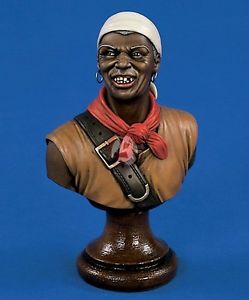
This week’s open threads will focus on a rarely known topic, black pirates.

Some estimate that nearly 5,000 pirates hunted prey between 1715 and 1726. Of that number, about twenty-five to thirty percent came from the cimarrons, black slaves who ran from their Spanish masters. Other blacks joined after pirates attacked slave ships. For example, when Sam Bellany and his fellow pirates seized a “Guinea Ship,” twenty-five blacks went on the account. Stede Bonnet’s crew also included former slaves and freemen, and of the eighty sea rovers who followed John Lewis were numbered at least forty blacks from English colonies. Francis Sprigg’s cook was black and entrusted with dividing the spoils equally for the crew.
Not all black pirates were known by name. For example, thirty men escaped enslavement on Saint Thomas and went on the account in August 1699. A mulatto amongst Stede Bonnet’s crew had a confrontation with a white sailor who refused to sign the articles of agreement. After cursing the man, the black pirate wondered “why I did not go to the pump and work among the rest, and told me that was my Business and that I should be used as a Negroe.” Captain Bonnet overheard the exchange and concurred with the pirate – a man was either a sea rover or a slave, regardless of his color or status.
In his article “Black Men under the Black Flag,” maritime historian Ken Kinkor includes a chart listing various pirate captains and how many blacks were members of their crews.
-
Samuel Bellamy (1717) – more than 27 out of 180 men
-
Edward England (1718) – less than 50 out of 180 men
-
Edward Lowther (1724) – 9 out of 23 men
-
Blackbeard (1717) – 60 out of 100; (1718) – 5 out 14
-
Oliver La Bouche (1719) – 32 out of 64 men
These five pirate crews are but a small sampling of those listed, and they indicate these men were active members of the crew. Sometimes, they were the most fearsome and most trusted of the pirates, the men who boarded prizes first. They did not, however, always receive the same punishment as other pirates when captured. Whereas their comrades often went to the gallows, black pirates were often returned to the men who owned them, or they were sold into slavery.
Henri Caesar (fl. 1791-1830) was allegedly a 19th-century Haitian revolutionary and pirate. Efforts to find historical evidence of his existence have been unsuccessful. According to works of fiction, he was a participant in the Haitian Revolution under Dutty Boukmanand Toussaint Louverture as well as active in piracy for nearly a 30-year period during the early 19th century.
Henri Caesar was allegedly born to a slave family kept by a French plantation owner known as Arnaut. He worked as a houseboy on the estate and, as a young man, worked in the lumberyard. He was apparently mistreated by the supervisor and later killed the man during the slave insurrection, torturing him with a saw. Joining the rebel forces led by Dutty Boukman and Toussaint Louverture, he remained with the revolution until its independence from France in 1804, when he left to try his luck at sea. Based in Port-de-Paix, he captured a Spanish ship in 1805 and soon began attacking small villages and lone vessels near Cuba and the Bahamas. Adopting the name Black Caesar, he was very successful during his piratical career before his disappearance in 1830. Although his fate is unrecorded, he most likely fled the area after President Andrew Jackson ordered an expedition against pirates active on the Florida coast after its purchase by the United States in 1828. There is one story of his capture in west Florida and, taken to Key West, was tied to a tree and burned to death. The widow of a preacher, whose eyes had been burned out under torture from Black Caesar, had been used to light the fire.
He is supposed to have buried between $2 and $6 million at several locations throughout the Caribbean including Pine Island, White Horse Key, Marco Island, Elliot Key and Sanibel Island, although none has ever been recovered. He is said to have been associated with another pirate, Jose Gaspar or Gasparilla, however his existence is doubted among historians.
*** Information courtesy of Cindy Vallar.com/blackpirates and Wikipedia.org***
